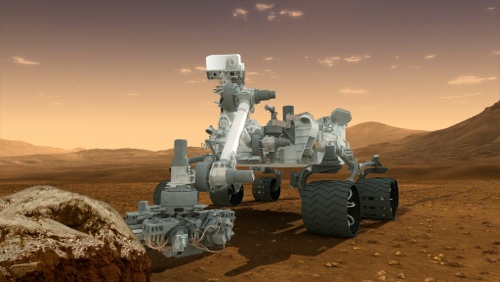NASA will attempting a daring landing – what some scientists are calling seven minutes of terror – of a wheeled rover called Curiosity on Mars soon. The landing will be on August 5 Pacific Daylight Time (August 6 EDT and UTC). The rover will be lowered by a rocket-powered sky crane to the Gale Crater, where it will spend a Martian year (about 1.88 Earth years) studying Mars geology and looking for signs of microbial life.
Video: Mars Curiosity rover’s seven minutes of terror
EarthSky spoke with planetary geologist John Grotzinger of CalTech, chief scientist of the Mars Science Laboratory mission. He told EarthSky:

I think the most important thing is the incredible capability that we are able to construct, with the help of thousands of engineers and scientists and land this thing on Mars. Mars is our nearest neighbor. Basically, we’re going to put a vehicle down on the surface on August 6 that is the size of a small car and has the capabilities of analytical laboratories of my home institution of CalTech.
The Curiosity rover will land at the foot of a three-mile-high (five-kilometer) mountain known as Mount Sharp in the 96-mile-wide (154-kilometer) Gale Crater. The rover will spend its martian year slowly rolling 12 miles along the Martian soil, stopping to drill a few centimeters in and analyze the powder for signs of a habitable environment. Grotzinger said:
And by that, what we mean is a place where there would have been water present; a source of energy, which is what organisms utilize to live with; and then a source of carbon, which is what all organisms for life as we know it are built out of. So water, energy, and carbon, for us, define the targets that we’re searching for with this mission.

Grotzinger said to expect the Curiosity rover to make some amazing discoveries on the history of the crimson planet.
What’s new about this mission is that it takes a significant step towards the challenge of eventual life-detection experiments on the surface of Mars. And the way that we do this intermediate step is by asking the question about exploring habitable environments. In this case, we presume that life may have evolved on Mars and then ask the question, if it did, what would be the kinds of habitats that microorganisms might reside in.
The Curiosity rover – due to land on Mars on August 5-6, 2012 – is the centerpiece of the Mars Science Laboratory (MSL) mission. NASA launched the mission in November 2011. The cost is about $2.5 billion. NASA’s Jet Propulsion Laboratory in Pasadena, California, is overseeing the mission.
Check out Mars landing sites of previous rovers and Curiosity











